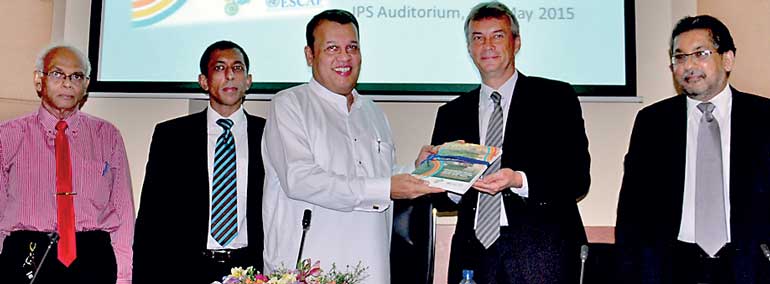Thursday Feb 27, 2025
Thursday Feb 27, 2025
Friday, 15 May 2015 01:01 - - {{hitsCtrl.values.hits}}

UNDP Country Director Joern Soerensen handing over the Economic and Social Survey of Asia and the Pacific 2015 to State Minister of Finance Mahinda Samarasinghe. Others present were Former Deputy Governor of the Central Bank of Sri Lanka W. A. Wijewardena, ESCAP Economic Affairs Officer Dr. Shuvojit Banerjee and IPS Executive Director Dr. Saman Kelegama
By Charumini de Silva
The United Nations’ Economic and Social Commission for Asia and the Pacific (ESCAP) yesterday cautioned Sri Lanka and other countries that were highly dependent on external funding that they may face policy challenges over the next few years.
ESCAP Economic Affairs Officer Shuvojit Banerjee said that with US monetary policy normalisation, the expected increase in US interest rates is likely to drive capital out of Asia Pacific.
“We foresee that countries that are dependent on external funding will, over the next year or two, face challenges,” said Banerjee.
He made these remarks at the launch of the Economic and Social Survey of Asia and the Pacific 2015 – Part I under the theme of ‘Making Growth More Inclusive for Sustainable Development’. A copy of the report was presented to the State Finance Minister Mahinda Samarasinghe by UNDP Country Director Joern Soerensen in Colombo.
Pointing out that a significant portion of the fiscal shortfall was financed through foreign funding, Banerjee asserted that as a result of this Sri Lanka’s external debt to GDP ratio was higher than that of most economies in the region, making the country more vulnerable to rising global interest rates in the coming years.
“In the year ahead this problem may really rise its head, especially for Sri Lanka and some other countries. This will create a dilemma in monetary policy for Governments: how to balance and bring down the interest rates because of declining inflation in a bid to support growth, while on the other side needing to preserve capital flows?” he explained.
In this context, countries which depend on external capital will face challenges.
Making a presentation of the Economic and Social Survey of Asia and the Pacific 2015 report, Banerjee highlighted Sri Lanka’s performance and said that they were quite hopeful over Sri Lanka’s economic outlook and predicted a 7.5% growth in 2015, which is a slight increase compared to the 7.4% recorded in 2014.
Growth is expected to remain at high rates of 7.5% in 2015 and 7.6% in 2016 on continued strength in private consumption. The inflation forecast will fall to 3% in 2015, down from 3.3% in 2014. Meanwhile, the investment will also continue to be strong from the ongoing reconstructing program and the Governments plan of increasing infrastructure spending.
Commenting on the export sector, he said that they predict a fairly good year because of the strong performance of the US. More than most other countries in the region, the US is an important trade partner for Sri Lanka and their good performance will help the apparel sector and other related industries.
“That is the good side but we also foresee challenges for Sri Lanka which may not creep up immediately but the Government will have to pay great consideration to this. This has really come down to what we call the twin deficit - current account deficit and the fiscal deficit,” he stated.
The current account deficit, which stood at close to 5% of GDP per year during the period from 2010-2014, reflects the high investment rate of about 30% of the GDP and yet low domestic saving rate. Thus, a greater role for the private sector, including FDI, in the economy is needed in order to raise exports and productivity.
On the fiscal side as well the problem is the budget deficit amounting to about 6% of the GDP per year during the period from 2010-2014. The primary cause of this is the declining role or continued difficulty to raise revenue to match the spending need.
Discover Kapruka, the leading online shopping platform in Sri Lanka, where you can conveniently send Gifts and Flowers to your loved ones for any event including Valentine ’s Day. Explore a wide range of popular Shopping Categories on Kapruka, including Toys, Groceries, Electronics, Birthday Cakes, Fruits, Chocolates, Flower Bouquets, Clothing, Watches, Lingerie, Gift Sets and Jewellery. Also if you’re interested in selling with Kapruka, Partner Central by Kapruka is the best solution to start with. Moreover, through Kapruka Global Shop, you can also enjoy the convenience of purchasing products from renowned platforms like Amazon and eBay and have them delivered to Sri Lanka.
Discover Kapruka, the leading online shopping platform in Sri Lanka, where you can conveniently send Gifts and Flowers to your loved ones for any event including Valentine ’s Day. Explore a wide range of popular Shopping Categories on Kapruka, including Toys, Groceries, Electronics, Birthday Cakes, Fruits, Chocolates, Flower Bouquets, Clothing, Watches, Lingerie, Gift Sets and Jewellery. Also if you’re interested in selling with Kapruka, Partner Central by Kapruka is the best solution to start with. Moreover, through Kapruka Global Shop, you can also enjoy the convenience of purchasing products from renowned platforms like Amazon and eBay and have them delivered to Sri Lanka.